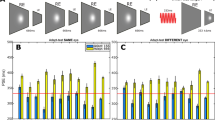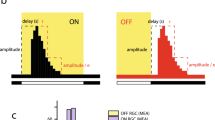Abstract.
Considering a variety of quite different candidate neural codes, Cheng and Wasserman [(1996) Biol Cybern 75, 93–103, 105–115] reported data which suggested that amplitude codes transmitted information more faithfully than temporal codes. Reanalyzing their data, the present study measured how well size and time represented information resident within the same neural response feature, namely the response peak. Responses from photoreceptor cells and optic nerve fibers in the peripheral visual system of Limulus polyphemus were therefore re-examined using signal detectability values provided by receiver-operating-characteristic analyses to compare how well the timing and the amplitude of the response peak represent information within a single cell and how well they transmit information between cells. Data were available for several cells in several different light-adaptation states onto which several different test-flash intensities had been superimposed. The present reanalysis of these data replicated the results yielded earlier by the peak candidate code, and compared them with the data produced by two different measurements of the timing of the same response peak. A relative-timing code was derived from measurements of the time that elapsed between the moment when the response exceeded a criterion potential and when it reached its peak. An absolute-timing code was derived from the time that elapsed between test flash onset and the peak. The results clearly indicated that the peak code represented information within cells better than either of the two timing codes. However, both peak and absolute-timing codes clearly transmitted the available information between cells more faithfully than the relative-timing code. These data lead to two conclusions. First, that the same response feature, when measured in different ways, can produce remarkably different information processing outcomes. In this particular case, time represented information resident within a cell less well than did size. Second, that the fidelity of information transmission between nerve cells may be relatively independent of the quantity of information resident within any particular cell.
Similar content being viewed by others
Author information
Authors and Affiliations
Additional information
Received: 5 November 2001 / Accepted in revised form: 8 July 2002
Acknowledgements. We are deeply indebted to Huiqi Yin for her technical assistance with all the calculations and the graphics. We also sincerely thank Tony Hosking, who wrote the computer programs that extracted the code data for this project, and Brendan Marr, who assisted with data analysis.
Correspondence to: G.S. Wasserman (e-mail: codelab@purdue.edu, Fax: +1-765-4961264)
Rights and permissions
About this article
Cite this article
Bolbecker, A., Cheng, Z. & Wasserman, G. Time versus size: which characteristic of a neural response carries more information?. Biol. Cybern. 88, 73–78 (2003). https://doi.org/10.1007/s00422-002-0345-y
Issue Date:
DOI: https://doi.org/10.1007/s00422-002-0345-y




